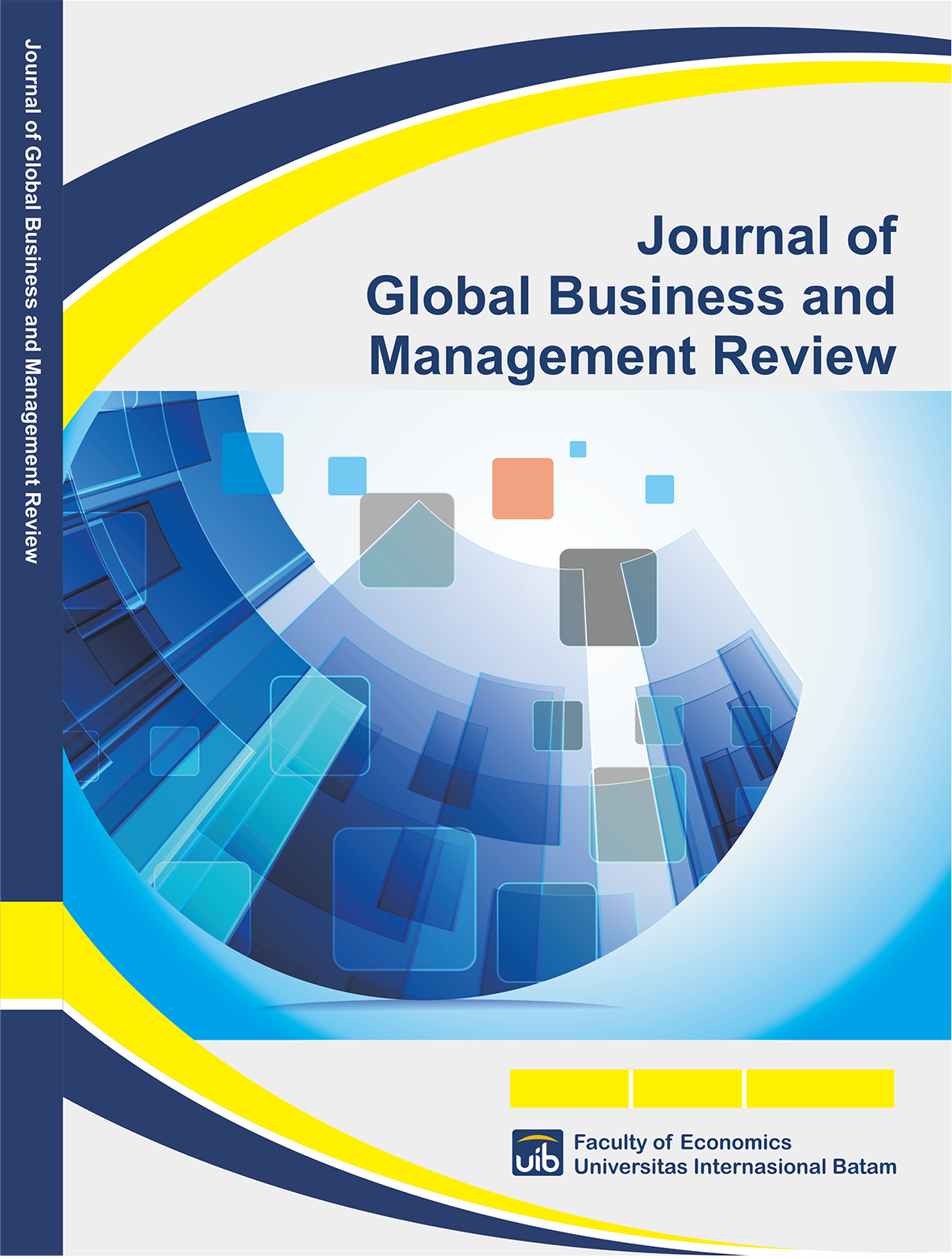Intention to Use Cryptocurrency in Batam City among Millennials
DOI:
https://doi.org/10.37253/jgbmr.v7i1.10118Abstract
The intention of individuals to use cryptocurrency is influenced by several factors, including financial literacy, herding behavior, and perceived risk. The purpose of this research is to explore how behavioral finance affects the intention to use cryptocurrency. This study employs a quantitative method. The sampling technique used is purposive sampling by distributing questionnaires based on certain criteria. Data is analyzed using the PLS-SEM method. The sample used for testing consists of 401 respondents who use cryptocurrency. The results of the study indicate that herding behavior and perceived risk have a significant influence on the variable of behavioral intention to use cryptocurrency. This research is important because, before deciding to invest in cryptocurrency, it is crucial for millennials to conduct thorough research, consider their individual risk profiles, and not just follow trends.
Downloads
References
Ajzen icek. (1991). Analysis in the light of the Theory of Planned Behaviour. Disability, CBR and Inclusive Development, 33(1), 52–68. https://doi.org/10.47985/dcidj.475
Alaklabi, S., & Kang, K. (2022). the Extended Tra Model for the Assessment of Factors Driving Individuals’ Behavioral Intention To Use Cryptocurrency. Interdisciplinary Journal of Information, Knowledge, and Management, 17, 125–149. https://doi.org/10.28945/4948
Almajali, D. A., Masa’Deh, R., & Dahalin, Z. M. d. (2022). Factors influencing the adoption of Cryptocurrency in Jordan: An application of the extended TRA model. Cogent Social Sciences, 8(1), 1–27. https://doi.org/10.1080/23311886.2022.2103901
Arias-Oliva, M., de Andrés-Sánchez, J., & Pelegrín-Borondo, J. (2021). Fuzzy set qualitative comparative analysis of factors influencing the use of cryptocurrencies in spanish households. Mathematics, 9(4), 1–19. https://doi.org/10.3390/math9040324
Avci, İ. (2023). Research on consumer opinions. 19(2), 311–328. http://dx.doi.org/10.17130/ijmeb.1184387%0A
Bappebti. (2022). Hingga Agustus, Investor Aset Kripto Naik Jadi 16,1 Juta. https://bappebti.go.id/pojok_media/detail/11410
BPS. (2021). Jumlah Penduduk Menurut Kelompok Umur dan Jenis Kelamin Berdasarkan Sensus Penduduk 2020. https://batamkota.bps.go.id/statictable/2021/02/23/86/jumlah-penduduk-menurut-kelompok-umur-dan-jenis-kelamin-berdasarkan-sensus-penduduk-2020.html
Caesaria Sandra Desi, K. A. P. (2023). Berapa Kisaran Gaji Lulusan SMA dan SMK Per Bulan? https://www.kompas.com/edu/read/2023/11/27/163000971/berapa-kisaran-gaji-lulusan-sma-dan-smk-per-bulan-simak-rinciannya#:~:text=Besaran gaji lulusan SMA dan,Rp 2.870.914 per bulan.
Candy, & Novita, I. (2021). Herding Behavior of Indonesia Investor : Role of. International Journal of Economics, Business and Accounting Research (IJEBAR), 2021(2), 296–303. https://jurnal.stie-aas.ac.id/index.php/IJEBAR/article/view/2465/1163
Cristofaro, M., Giardino, P. L., Misra, S., Pham, Q. T., & Hiep Phan, H. (2023). Behavior or culture? Investigating the use of cryptocurrencies for electronic commerce across the USA and China. Management Research Review, 46(3), 340–368. https://doi.org/10.1108/MRR-06-2021-0493
da Gama Silva, P. V. J., Klotzle, M. C., Pinto, A. C. F., & Gomes, L. L. (2019). Herding behavior and contagion in the cryptocurrency market. Journal of Behavioral and Experimental Finance, 22, 41–50. https://doi.org/10.1016/j.jbef.2019.01.006
Didit. (2023). Bulan Literasi Aset Kripto 2023, Masyarakat Harus Makin Paham. Kominfo. https://www.kominfo.go.id/content/detail/47201/bulan-literasi-aset-kripto-2023-masyarakat-harus-makin-paham/0/berita
Dihni Vika Azkiya. (2022). Pengusaha di Indonesia Paling Banyak Lulusan SMA. https://databoks.katadata.co.id/datapublish/2022/02/17/pengusaha-di-indonesia-paling-banyak-lulusan-sma
Fetesond, M., & Cakranegara, P. A. (2022). Pengaruh Literasi Keuangan, Kemampuan Akademis, Dan Pengalaman Bekerja Terhadap Perilaku Keuangan Mahasiswa. Jurnal Ekonomi Dan Bisnis, 9(1), 259–274. https://stiemuttaqien.ac.id/ojs/index.php/OJS/article/view/333/226
Hasnain, M. N., & Subhan, Q. (2022). Effect of herding behavior and overconfidence bias on investor’s financial decisions: A case of investment in crypto currency in Pakistan. In Journal of Management Info. https://readersinsight.net/jmi/article/view/2677%0Ahttps://readersinsight.net/jmi/article/download/2677/1894
Hidayah, A. L. (2023). Yuk, Berkenalan dengan Kripto! Kementerian Keuangan Republik Indonesia. https://www.djkn.kemenkeu.go.id/kpknl-tangerang1/baca-artikel/16059/Yuk-Berkenalan-dengan-Kripto.html#:~:text=Mengapa uang kripto menjadi populer,pendistribusiannya bisa melalui berbagai komputer.
Icek, A. (1985). From intentions to actions: a theory of planned behavior. Action Control, 11–39.
Izlah. (2024). Apa itu Herding Behavior? https://investsocial.com/id/forum/area-diskusi-trading/ensiklopedia-forex-kontes-jawaban-terbaik/67921-apa-itu-herding-behavior
Jariyapan, P., Mattayaphutron, S., Gillani, S. N., & Shafique, O. (2022). Factors Influencing the Behavioural Intention to Use Cryptocurrency in Emerging Economies During the COVID-19 Pandemic: Based on Technology Acceptance Model 3, Perceived Risk, and Financial Literacy. Frontiers in Psychology, 12(February). https://doi.org/10.3389/fpsyg.2021.814087
K. R. Ramprakash, Kishore Kunal, C. Joe Arun, M. J. Xavier. (2023). an Exploratory Study on the Factors Affecting the Intention To Use Cryptocurrency As a Medium of Exchange. Russian Law Journal, 11(5s), 371–384. https://doi.org/10.52783/rlj.v11i5s.956
Kengatharan, L., & Kengatharan, N. (2019). The Influence of Behavioral Factors in Making Investment Decisions and Performance: Study on Investors of Colombo Stock Exchange, Sri Lanka. Asian Journal of Finance & Accounting, 6(1), 1. https://doi.org/10.5296/ajfa.v6i1.4893
Li, C., Khaliq, N., Chinove, L., Khaliq, U., Popp, J., & Oláh, J. (2023). Cryptocurrency Acceptance Model to Analyze Consumers’ Usage Intention: Evidence From Pakistan. SAGE Open, 13(1), 1–19. https://doi.org/10.1177/21582440231156360
Liaqut, S., & Siddiqui, A. (2021). Crypto Currency Cognizance: A New Entrant in Financial Heaven. KIET Journal of Computing and Information Sciences, 4(2), 15. https://doi.org/10.51153/kjcis.v4i2.71
Liu, Y., & Tsyvinski, A. (2019). Risks and returns of cryptocurrency. Working paper. NBER Working Paper, 24877, 1–68. http://www.nber.org/papers/w24877
Mahwan, I. B. P. F., & Herawati, N. T. (2021). Pengaruh Literasi Keuangan, Persepsi Risiko, dan Locus of Control Terhadap Keputusan Investasi Pengusaha Muda di Singaraja. JIMAT (Jurnal Ilmiah Mahasiswa Akuntansi), 12(3), 768–780. https://repo.undiksha.ac.id/6498/
Marheni, D. K., Manajemen, P. S., Ekonomi, F., & Batam, U. I. (2020). Analisis Faktor Financial Attitude , Financial Behavior , Financial Knowledge , Propensity To Indebtedness , Compulsive Buying Dan Materialism Terhadap Financial Literacy Di Masyarakat. 4(2), 210–219.
Marheni, D. K., & Nuzula Agustin, I. (2023). Cryptocurrency decision analysis as an instrument in modern financial markets through investment intention. Jurnal Manajemen Dan Pemasaran Jasa, 16(2), 237–254. http://dx.doi.or
Meng, S., & Bhaumik, A. (2022). Socioeconomic and Technological Variables Affecting Cryptocurrency and its Future-A Review. International Journal on Recent Trends in Business and Tourism, 7(January), 1–17. https://doi.org/10.31674/ijrtbt.2023.v07i01.001
Mentari Puspadini. (2024). Media Asing Soroti Kripto RI, Singgung Jumlah Investor dan Aturan. Cnbc Indonesia. https://www.cnbcindonesia.com/market/20240326085317-17-525383/media-asing-soroti-kripto-ri-singgung-jumlah-investor-dan-aturan#:~:text=Diketahui%2C Indonesia telah melegalkan kripto,melarang penggunaannya sebagai metode pembayaran.
Miko, S., Wahyu, A., Atmaja, T., Mawardah, R., & Zulfa, S. D. (2023). The Impact of Competitiveness , Information Technology , Risk Perception , and Financial Literacy on The Intention to Invest in Cryptocurrency. 5(1), 1–7. https://aptikom-journal.id/itsdi/article/view/602
Ningrum, P. A. P. (2023). Pengaruh Literasi Keuangan, Risk Tolerance, dan Overconfidence Terhadap Pengambilan Keputusan Investasi Cryptocurrency Pada Mahasiswa Fakultas Ekonomi Universitas Pendidikan Ganesha. Undiksha Repository. https://repo.undiksha.ac.id/15743/3/1917051030-BAB 1 PENDAHULUAN.pdf
Patel, A. K., Singh, M., Patel, A. K., & Singh, K. (2021). Mapping of Global Research Trends in Financial Literacy: A Scientometric Approach. Library Philosophy and Practice, 2021, 1–19.
Ramadani, A. G., Tubastuvi, N., Fitriati, A., & Widhiandono, H. (2023). Millennials’ Investment Decision in Capital Market Investment With Financial Behavior as An Intervening Variable. Riset Akuntansi Dan Keuangan Indonesia, 7(3), 355–375. https://doi.org/10.23917/reaksi.v7i3.21650
Sagheer, N., Khan, K. I., Fahd, S., Mahmood, S., Rashid, T., & Jamil, H. (2022). Factors Affecting Adaptability of Cryptocurrency: An Application of Technology Acceptance Model. Frontiers in Psychology, 13(June), 1–12. https://doi.org/10.3389/fpsyg.2022.903473
Wisnu Saputra, G., & Maradona, A. F. (2023). The Effect of Herding Behavior on Millennial Generation Intentions in Investing Crypto Assets. International Journal of Social Science and Business, 7(2), 326–334. https://doi.org/10.23887/ijssb.v7i2.55119
Zis, S. F., Effendi, N., & Roem, E. R. (2021). Perubahan Perilaku Komunikasi Generasi Milenial dan Generasi Z di Era Digital. Satwika : Kajian Ilmu Budaya Dan Perubahan Sosial, 5(1), 69–87. https://doi.org/10.22219/satwika.v5i1.15550
Downloads
Published
Issue
Section
License
Copyright (c) 2025 Journal of Global Business and Management Review

This work is licensed under a Creative Commons Attribution-NonCommercial-ShareAlike 4.0 International License.















